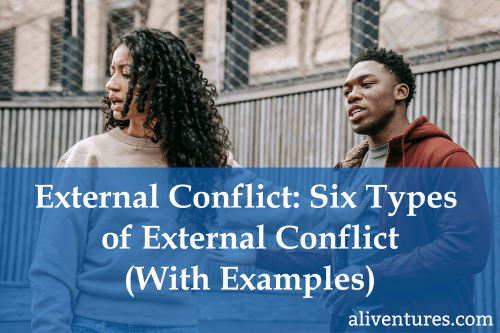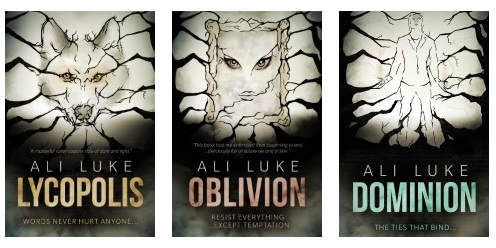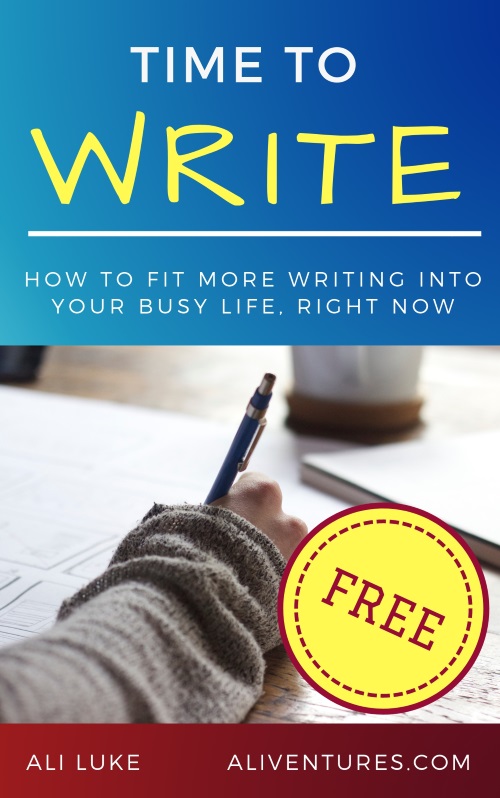External Conflict: Six Types of External Conflict (With Examples)

A couple of weeks ago, we looked at internal conflict in detail: when a character is facing a struggle that’s taking place within their own mind.
Today, we’re going to look at some examples of different kinds of external conflict. You’ll normally need at least one type of external conflict in your story—it’s going to be a large part of what drives the narrative.
What is External Conflict?
External conflict is the struggle between a character (usually your main character) and some kind of outside force. Quite often, that’s another character such as the antagonist—but it could also be society as a whole, the environment in which they exist, a supernatural force, or even fate.
A well-written story will generally have both internal and external conflict. Often, one will feed into the other (e.g. a character’s self-doubt might be fuelled by a bully at work, or their struggle to choose between two love interests may be complicated by the society in which they live).
Why Does External Conflict Matter?
I can just about imagine a short story with only internal conflict: all the problems exist inside the character’s head. But normally, a good story is going to need characters who face external issues—and overcome them.
Story structure is really built around this kind of external conflict. The status quo is broken by some kind of inciting event: the first hint of an external conflict. During the first half of the book, the character will generally be reacting to this change and all that it means for them. Around the midpoint, something changes—and your character is really fighting for something from this point on.
When the story reaches its climax, this means your character facing the external force: defeating the antagonist, in many cases, or in less character-vs-character conflicts, embracing/avoiding their face, overcoming the dangers of their environment, or even changing their whole society.
Without external conflict, or with only a little bit of external conflict, your story is probably going to be boring. Either your character gets what they want remarkably easily, or they spend a lot of time whining and moping around for no real reason. External conflict gives them something to fight for (plus it’ll often be a clear and valid cause for internal conflict).
The type and severity of external conflict will vary depending on your genre (and, often, the length of your story). A sweet romance novella isn’t going to involve the same kind of conflict as a high-stakes thriller novel. But whatever you’re writing, some form of external conflict should be there. One way or another, your characters need to suffer.
Six Types of External Conflict to Use in Your Fiction (Plus External Conflict Examples)
Many types of external conflict will overlap with one another or could be framed in slightly different ways – so this list isn’t intended to be exhaustive! Hopefully, it’ll help give you some ideas for ways to include external conflict as you plan, draft, or redraft your story.
1. Character vs Character
Character vs character is probably the most common form of external conflict—and it can be an obvious manifestation of other types of conflict (particularly character vs society).
If your novel has an antagonist (or villain) character, then that’s an obvious source of character vs character conflict.
Example:
‘You’ll soon find out some wizarding families are much better than others, Potter. You don’t want to go making friends with the wrong sort. I can help you there.’
He held out his hand to shake Harry’s, but Harry didn’t take it.
‘I think I can tell who the wrong sort are for myself, thanks,’ he said, coolly.
Draco Malfoy didn’t go red, but a pink tinge appeared in his pale cheeks.
‘I’d be careful if I were you, Potter,’ he said slowly. ‘Unless you’re a bit politer you’ll go the same way as your parents. They didn’t know what was good for them, either. You hang around with riff-raff like the Weasleys and that Hagrid and it’ll rub off on you.’
– from Harry Potter and the Philosopher’s Stone, J.K. Rowling
This scene is where Harry and Draco meet for the first time. It’s clear they’re not going to be friends, with Harry immediately put off by Draco’s snobbery—which Draco then follows up with a spiteful reference to Harry’s dead parents. This scene kicks off one of the key character vs character conflicts in the whole Harry Potter series.
2. Character vs Environment
A character vs environment conflict is when the character’s struggle is against the physical world around them. That might be nature, or the natural world: for instance, a character stranded on a desert island will face a huge amount of environmental conflict.
Character vs environment conflict might involve animals – particularly dangerous ones. (If the animal talks or shows an unusual degree of intelligence, or if all the characters are animals, you might instead characterise this as character vs character conflict.)
Example:
November was here, and it frightened her because she knew what it brought – cold upon the valley like a coming death, glacial wind through the cracks between the cabin logs. But most of all, darkness, Darkness so complete even the pale-lit hours would be choked.
She entered last winter blind, not knowing what to expect in this new, hard land. Now she knew. By December, the sun would rise just before noon and skirt the mountaintops for a few hours of twilight before sinking again. Mabel would move in and out of sleep as she sat in a chair beside the woodstove. She would not pick up any of her favorite books; the pages would be lifeless. She would not draw; what would there be to capture in her sketchbook? Dull skies, shadowy corners.
– from The Snow Child, Eowyn Ivey
What I love about this example is not just the harsh environment and the physical difficulties like the cold and lack of sunlight, but also the mental effect that it has on Mabel: how she’s unable to read and draw because her world has become one of “dull skies” and “shadowy corners.” It’s a great demonstration of how external conflict can cause or be mirrored by internal conflict.
3. Character vs Society
A character vs society conflict is also about a character’s struggle with their world – but this time, it’s a social world of people, rather than their environment.
Character vs society could involve a close-knit society (perhaps even their own family), or it could be about a struggle against a much bigger level of society, like a national or even international government.
Example:
On each landing, opposite the lift-shaft, the poster with the enormous face gazed from the wall. It was one of those pictures which are so contrived that the eyes follow you about when you move. BIG BROTHER IS WATCHING YOU, the caption beneath it ran. […] There was of course no way of knowing whether you were being watched at any given moment. How often, or on what system, the Thought Police plugged in on any individual wire was guesswork. It was even conceivable that they watched everybody all the time. But at any rate they could plug in your wire whenever they wanted to. You had to live–did live, from habit that became instinct–in the assumption that every sound you made was overheard, and, except in darkness, every movement scrutinized.
– from Nineteen Eighty-Four, George Orwell
The idea here of being watched “whenever they wanted to” by the Thought Police is a chilling, stifling one. Orwell paints a picture of a world where “thoughtcrime” (thinking something that conflicts with what the Party wants you to think) is a criminal offence. A character vs society conflict will often involve some level of internal conflict, where the character is struggling to hold true to themselves despite the pressures of the society around them.
4. Character vs Supernatural
Some characters have magical powers or special abilities, but they’re essentially still human. But what if you have some kind of force or magical being that goes beyond this?
A character vs supernatural conflict is when your character is fighting something that’s well beyond being human—and that may well not have anything like human morality or human limitations. Whether it’s an unfathomable Lovecraftian horror, an innocent-seeming fairy, or some kind of supernatural object with menacing powers, it could cause huge obstacles for the protagonist.
Example:
Gandalf looked again very hard at Bilbo, and there was a gleam in his eyes. ‘I think, Bilbo,’ he said quietly, ‘I should leave [the ring] behind. Don’t you want to?’
‘Well yes – and no. Now it comes to it, I don’t like parting with it at all, I may say. And I don’t really see why I should. Why do you want me to?’ he asked, and a curious change came over his voice. It was sharp with suspicion and annoyance. ‘You are always badgering me about my ring; but you have never bothered me about the other things that I got on my journey.’
– from The Lord of the Rings, by J.R.R. Tolkein
In The Lord of the Rings, the ring that Bilbo found in The Hobbit is revealed to be the One Ring, as Gandalf discovers—having become even more curious and concerned about the nature of Bilbo’s magic ring after seeing Bilbo’s behaviour here. The ring isn’t merely a tool of evil but has some degree of power of its own: it’s been prolonging Bilbo’s life unnaturally, and we see its corrupting influence here.
5. Character vs Fate
Another type of conflict is a character vs fate. This one goes way back to early literature like the story of Oedipus (who, in trying to flee his prophesied fate, ends up killing his father and marrying his mother).
Today, stories about “fate” aren’t necessarily supernatural in form. A character’s “fate” could be a serious diagnosis or even a criminal sentence. What’s intriguing about this type of conflict is that, often, the story isn’t about how the character overcomes their fate but instead about how they accept or handle it.
Example:
I got to study Will Traynor up close, in those first couple of weeks. I saw that he seemed determined not to look anything like the man he had been; he had let his light-brown hair grow into a shapeless mess, his stubble crawl across his jaw. His grey eyes were lined with exhaustion, or the effort of constant discomfort (Nathan said he was rarely comfortable). They bore the hollow look of someone who was always a few steps removed from the world around him. Sometimes I wondered if it was a defence mechanism, whether the only way to cope with his life was to pretend it wasn’t him it was happening to.
– from Me Before You, JoJo Moyes
Apologies in advance for spoilers (Me Before You was published in 2007, and the film version came out in 2016, so I’m hoping you’ve already read/seen it if you’re interested in it). After a road accident, Will’s fate is written: he’s a quadriplegic and there’s no prospect of him getting better. He hates what his life has become – dependent on others for his every need – and is determined to end it.
Despite the efforts of the narrator, Louisa, and Will’s family, he goes through with what he wants. As the readers, we feel it’s the right choice for him: his way to avoid succumbing to his fate.
6. Character vs Technology
One final form of external conflict is between a character and technology. This could be almost anything, from a technically inept character who can barely turn on their phone to a high-tech story where the main character is desperately trying to shut down a deadly technology.
If the technology itself is human-like in its behaviour (e.g. it’s an advanced Artificial Intelligence) then that would be more of a character vs character conflict.
Example:
I could have become a mass murderer after I hacked my governor module, but then I realized I could access the combined feed of entertainment channels carried on the company satellites. It had been well over 35,000 hours or so since then, with still not much murdering, but probably, I don’t know, a little under 35,000 hours of movies, serials, books, plays, and music consumed. As a heartless killing machine, I was a terrible failure.
I was also still doing my job, on a new contract, and hoping Dr. Volescu and Dr. Bharadwaj finished their survey soon so we could get back to the habitat and I could watch episode 397 of Rise and Fall of Sanctuary Moon.
I admit I was distracted. It was a boring contract so far and I was thinking about backburnering the status alert channel and trying to access music on the entertainment feed without HubSystem logging the extra activity.
– from All Systems Red, Martha Wells
The first-person narrator in All Systems Red is a security unit (SecUnit) that calls itself “MurderBot”, assigned to help a survey team on an unexplored planet. It’s a sort of robot, though with some organic parts and human-like emotions. Part of the conflict in this novel is between MurderBot and the technology that’s supposed to control it (the governor module, which MurderBot has successfully hacked, and the HubSystem, which monitors all activity of the team).
External conflict is often easier to write than internal conflict, because it lends itself to action. Character versus character conflict might be expressed in an argument or fight; character versus environment conflict could put your character in a situation that requires all their physical strength; character versus fate may lead them to take actions they’d never otherwise contemplate, and so on.
Of course, you don’t want to throw in lots of external conflict just for the sake of it. The conflict needs to help you advance your story and themes, leading towards the climax where your character prevails against the characters or forces that have been working against them.
If you’ve got any great examples of external conflict in fiction (whether that’s in something you’ve read or watched or something you’re writing), go ahead and share them with us in the comments below.
About

I’m Ali Luke, and I live in Leeds in the UK with my husband and two children.
Aliventures is where I help you master the art, craft and business of writing.
Start Here
If you're new, welcome! These posts are good ones to start with:
Can You Call Yourself a “Writer” if You’re Not Currently Writing?
The Three Stages of Editing (and Nine Handy Do-it-Yourself Tips)
My Novels

My contemporary fantasy trilogy is available from Amazon. The books follow on from one another, so read Lycopolis first.
You can buy them all from Amazon, or read them FREE in Kindle Unlimited.


0 Comments